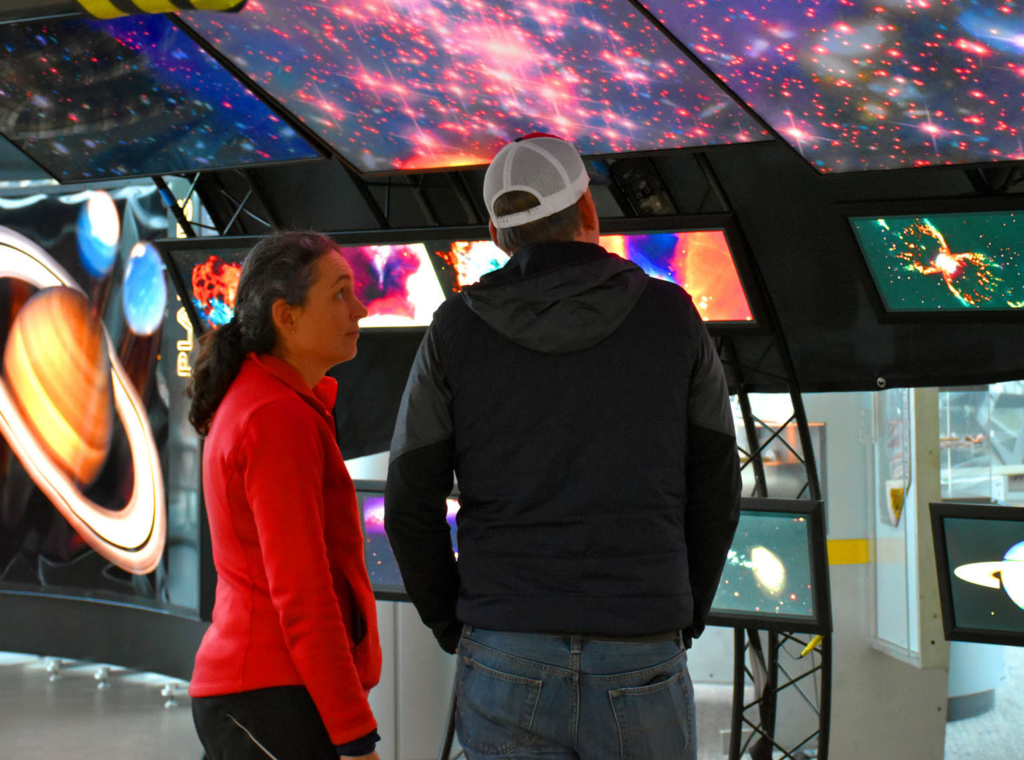As locals and travelers enter Mississippi from Louisiana, they observe a massive Saturn V rocket, which was used to send the first man to the moon in 1969.
As space-age thrill-seekers enter the INFINITY Science Center that houses the rocket, they will find an exhibit showcasing some of the most breathtaking high-resolution images of stars, galaxies, and planets captured by the Hubble Space Telescope. This exhibit represents the center’s educational mission to bring science to the masses.
“I would describe us as a one-stop shop for all things STEM,” said the center’s chief executive officer, Michelle Coleman Anderson.
The Hubble Traveling Exhibit is a 2,200-square-foot traveling NASA exhibit featuring a scale model of the Hubble and artifacts from the satellite’s history, as well as a selection of the revolutionary images captured by the satellite since its 1990 launch.
The exhibit, which debuted at INFINITY in February and is scheduled to continue through September, also explores the history of the universe and human exploration of the stars. In the exhibit, Hubble is used to explain both the past and present scientific developments in the universe.
“It also introduces the telescope about which you may be hearing more these days, the James Webb Space Telescope,” said Anderson. “The Hubble has its own mission, but it serves as a segue to the James Webb.”

The Hubble exhibit explores the past, present, and future by showcasing the tools astronauts use to service satellites, demonstrations of multiple imaging techniques aboard the telescope, and interactive examples of the heat resistant material that comprises the telescope.
The enigma surrounding the mission
Anderson described the Hubble exhibit as an immersion into “the mystery of the Hubble mission” that joins the INFINITY Center’s other exhibits about terrestrial and extraterrestrial scientific exploration, such as artifacts from multiple Apollo missions, such as a Saturn V spacecraft’s booster rocket.
While the INFINITY Center is not a NASA facility, it works closely with the nearby John C. Stennis Space Center, NASA’s largest rocket testing facility. Other adjacent facilities, such as NASA’s Michoud Assembly Facility in New Orleans, where components for the Apollo missions and the space shuttle were assembled, contribute to INFINITY’s comprehensive annals of American space travel.
INFINITY is intended to provide visitors with a comprehensive view of physical science, with exhibits beginning with the oceans, progressing to the Earth, and concluding with space and man’s exploration of it on the second floor.

Increasing the purview
Anderson explained that the inclusion of the Hubble exhibit is a stepping stone toward more traveling exhibits designed to expand the center’s mission to inspire, amaze, and engage visitors of all ages, particularly the regular schedule of school tours from New Orleans and surrounding areas.
The center, which offers hands-on education in a variety of scientific disciplines, is an invaluable resource for instructors seeking to help students apply abstract concepts.
The Academy of Our Lady high school physics instructor Kristen Haynes recently stated that her students, who are currently studying the forces that govern the universe, find the center “really engaging.”
Haynes stated, “Physics can be abstract if it is only taught in the classroom and on paper.” “However, exposing them to opportunities to see it in action and to see how the formulas and concepts we learn are directly applied to real-world occurrences is beneficial.”
Local associations
Beth Dillmann, a teacher of eighth-grade physical science at Mt. Carmel, explained that bringing her students to INFINITY enables them to understand the historical and contemporary connections between Louisiana and Mississippi and the space program.
Another advantage of the institute is its ability to promote scientific career opportunities, particularly for women in STEM disciplines. Haynes and Dillmann both expressed the optimism that visits to the center will encourage students to pursue STEM careers, emphasizing that they could be among the next generation of astronauts to return to the moon or settle on Mars.
Haynes stated, “I want to empower my students and demonstrate that they can accomplish anything they set their minds to.” In a cliched manner, strive for the heavens.
